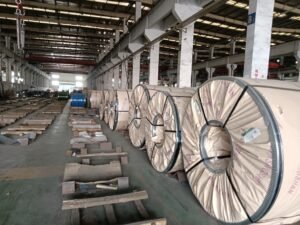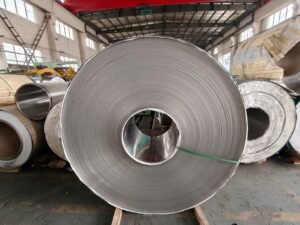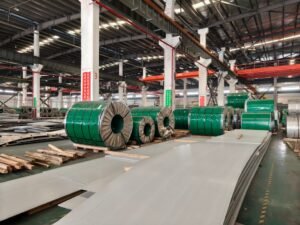Introduction
Choosing the right carbon steel for your project can make or break your results. Metal fabricators and industrial manufacturers often struggle with balancing cost, strength, and precision. Should you go for hot-rolled or cold-rolled? The wrong choice could mean rework or wasted resources.
That’s where understanding Hot-Rolled vs. Cold-Rolled Carbon Steel becomes essential. Hot-rolled offers cost-effective strength for structural needs, while cold-rolled delivers superior surface quality and tighter tolerances for precision applications. In this comparison guide, we’ll break down their differences, applications, and how to pick the best option for your needs.
Introduction to Hot-Rolled vs. Cold-Rolled Carbon Steel
Let’s dive into the world of steel, specifically Hot-Rolled vs. Cold-Rolled Carbon Steel. These two types of steel are super important in industries like construction and manufacturing, and knowing the difference can help you pick the right one for your project.
Steel is everywhere—think of cars, buildings, and even the tools we use. But not all steel is the same. The way it’s processed, like with hot rolled steel or cold rolled steel, changes its strength, look, and best uses. So, let’s break it down step by step.
Defining Hot-Rolled Carbon Steel: Basics and Characteristics
Hot rolled steel is made by heating steel above 1700°F and then rolling it into shape. This process makes it easier to form, which is why it’s often used for big, structural items like beams and rails. It has a rough surface and isn’t super precise, but it’s tough and usually cheaper.
One thing to note is that hot rolled steel can have a bit of a scaly finish due to cooling at room temperature. That’s no biggie for projects where looks don’t matter, but it might not be your first pick for something fancy.
Defining Cold-Rolled Carbon Steel: Core Features and Benefits
On the flip side, cold rolled steel is processed at room temperature after being hot rolled. This extra step makes it stronger, smoother, and more precise in size. If you’re working on something where the surface finish or tight measurements are key, this is your go-to.
The smooth look of cold rolled steel also makes it great for things you’ll see, like car panels or appliances. Plus, it can handle more stress, which is awesome for detailed work. But, it does often cost a bit more because of the added processing.
Importance of Choosing the Right Steel Type for Project Success
Picking between hot rolled and cold rolled steel isn’t just a random choice. It directly affects how well your project turns out, from durability to cost. For instance, using the wrong type could mean spending extra money or ending up with something that doesn’t last.
Here at HnL Steel, we get how vital this decision is. That’s why we offer a wide range of steel products and tailored solutions to match your specific needs. Our goal is to help fabricators like you succeed with the best materials for the job.
Brief Overview of Applications in Manufacturing and Fabrication
Both types of steel shine in different areas. Hot rolled steel is often found in heavy-duty stuff like shipbuilding or railroad tracks, where strength beats appearance. Cold rolled steel, though, is perfect for finer jobs like furniture or automotive parts that need a polished look.
Understanding the differences between hot rolled and cold rolled steel can really give you an edge. And speaking of edges, we’ve got to say that cold rolled often wins on aesthetics with its slick finish, especially for visible or precision-based projects.
“Choosing between hot-rolled and cold-rolled carbon steel can make or break a project, as each type offers unique strengths for specific industrial needs.”
Let’s take a closer look at some hard facts. Below is a table comparing key aspects of Hot-Rolled vs. Cold-Rolled Carbon Steel. It’ll help you see why one might fit your needs better than the other.
Comparison of Hot-Rolled and Cold-Rolled Carbon Steel
| Property | Hot Rolled Steel | Cold Rolled Steel | Typical Use Case | Industry Benchmark |
|---|---|---|---|---|
| Surface Finish | Rough, Scaly | Smooth, Polished | Structural vs. Aesthetic | Smooth for Visible Parts |
| Strength (Yield) | Lower (~36 ksi) | Higher (~50 ksi) | Heavy Loads vs. Precision | 40 ksi Average |
| Cost per Ton (USD) | ~600-700 | ~800-900 | Budget vs. Quality Focus | 750 Avg. (2023) |
| Dimensional Tolerance | Less Precise | Highly Precise | General vs. Tight Fit | +/- 0.01 inch Ideal |
| Processing Temp (°F) | Above 1700 | Room Temp | Forming vs. Finishing | N/A |
Note: Costs are approximate based on 2023 market trends from sources like SteelBenchmarker. Strength values (ksi) reflect typical yield strength for carbon steel grades. Tolerances and finish matter more in industries like automotive, where precision drives choices.
Steel can be a real game-changer when you pick the right type! Whether you’re building something huge or crafting detailed pieces, knowing these basics sets you up for success. Stick with us as we explore more about steel applications in future chapters.
Manufacturing Processes: How Hot-Rolled and Cold-Rolled Steel Differ
Let’s explore how steel is made, focusing on Hot-Rolled vs. Cold-Rolled Carbon Steel. The way steel is processed changes its strength, look, and best uses, so understanding these steps can help you pick the right type for your project.
Steel isn’t just metal pulled out of the ground—it’s shaped through specific methods. These steel manufacturing processes directly affect the final product. So, let’s break down the two main ways carbon steel is made and what that means for you.
Hot-Rolled Steel Production: High-Temperature Rolling and Shaping
Hot-rolled steel starts with heating steel slabs to over 1700°F until they’re red-hot and pliable. Then, they’re passed through rollers to shape them into sheets or beams. This high heat makes the steel easy to form, perfect for big items like structural supports.
The catch? Cooling at room temp can leave a rough, scaly surface. It’s not always pretty, but it gets the job done for projects where looks aren’t the focus.
Cold-Rolled Steel Production: Room-Temperature Processing and Work Hardening
Cold-rolled steel takes things a step further. After hot rolling, the steel cools down and then gets rolled again at room temperature. This process, called work hardening, boosts strength and creates a smooth finish with tighter measurements.
That extra step means cold-rolled steel often shines in jobs needing precision, like car parts. It’s a bit more work to make, but the polished result is worth it for certain uses.
Impact of Temperature on Steel Structure and Performance
Temperature plays a huge role in a steel’s final traits. Hot rolling at high heat allows the steel’s grains to reform, making it more flexible but less strong. Cold rolling, with no heat, compresses those grains, adding strength and hardness.
So, if you’re wondering, how do the manufacturing processes affect steel properties?—it’s all about heat and pressure. These factors decide if the steel will bend easily or stand firm under stress.
Finishing Techniques and Their Effect on Final Product Quality
After rolling, finishing steps like cleaning or coating can change the steel’s look and durability. Hot-rolled steel often skips fancy finishes since it’s used for rough jobs. Cold-rolled steel, though, might get extra care to highlight its sleek surface, especially for visible products.
This focus on finish makes cold-rolled steel a top pick for aesthetics and tight tolerances. At HnL Steel, we prioritize sourcing high-quality steel through precise methods, ensuring consistency for bulk orders and custom specs.
“The manufacturing process of steel, whether hot or cold rolling, shapes its core properties, making each type ideal for specific industrial applications.”
Let’s dive into some hard data. Below is a table that breaks down key differences in the carbon steel comparison, showing how each process impacts the final material.
Manufacturing Process Impact on Steel Properties
| Aspect | Hot-Rolled Steel | Cold-Rolled Steel | Key Application | Industry Standard |
|---|---|---|---|---|
| Processing Temp (°F) | Above 1700 | Room Temp | Structural vs. Precision | N/A |
| Strength (Yield, ksi) | ~36 | ~50 | Heavy Duty vs. Detailed | 40 ksi Avg. |
| Surface Finish | Rough, Scaly | Smooth, Polished | Hidden vs. Visible | Smooth for Display |
| Grain Structure | Larger, Reformed | Compressed, Tight | Flexible vs. Rigid | Tight for Strength |
| Production Speed | Faster | Slower | Mass vs. Specialty | Balanced Output |
Note: Yield strength values are typical for carbon steel grades per ASTM standards. Grain structure affects flexibility—larger grains (hot-rolled) bend easier, while compressed grains (cold-rolled) resist deformation. Surface finish impacts use in visible or precision applications.
Man, picking the right steel is no small task, but it’s totally clutch for your project’s success! These processes shape what steel can do, and we’re excited to dig deeper in future chapters. Stay tuned for more on steel applications.
Comparing Properties: Strength, Surface Finish, and Durability
Let’s dive into the details of Hot-Rolled vs. Cold-Rolled Carbon Steel and see how their properties stack up. Understanding these differences can help you decide which steel fits your project best.
Steel isn’t just steel—it varies a lot based on how it’s made. When it comes to property differences in steel types, factors like strength, surface quality, and durability play a huge role. So, let’s break down what makes Hot-Rolled vs. Cold-Rolled Carbon Steel unique.
Strength and Toughness: Hot-Rolled’s Malleability vs. Cold-Rolled’s Hardness
Hot-rolled steel is known for being easier to shape thanks to its processing at high temperatures. This makes it more malleable, so it’s great for big structural jobs where bending or forming is needed. But it’s not as hard or resistant to stress as other options.
Cold-rolled steel, on the flip side, is processed at room temp, which makes it harder and stronger. It can handle more pressure without deforming, perfect for detailed or high-stress tasks. That extra strength comes from a process called work hardening.
Surface Finish: Rough Texture of Hot-Rolled vs. Smooth Polish of Cold-Rolled
If looks matter, surface finish is a big deal. Hot-rolled steel has a rough, scaly texture from cooling after being heated up high. It’s fine for hidden or industrial uses but not ideal for anything on display.
Cold-rolled steel, though, has a smooth, polished look that’s way more appealing. This makes it a top pick for visible items like car panels or appliances. At HnL Steel, we supply cold rolled steel for precision applications where that sleek finish is key.
Durability and Corrosion Resistance Across Environments
Durability is about how well steel holds up over time. Both types can be tough, but hot-rolled steel might show wear faster if exposed to harsh conditions due to its rough surface. Adding coatings can help with corrosion, though.
Cold-rolled steel often resists wear better thanks to its smoother surface, which doesn’t trap moisture as easily. Still, neither type is naturally corrosion-proof—environment and maintenance make a big difference in lifespan.
Precision and Tolerances: Cold-Rolled’s Advantage in Detailed Work
When precision counts, cold-rolled steel usually wins. Its tighter tolerances mean it’s cut and shaped with more accuracy, ideal for intricate designs or parts that must fit perfectly. Not sure when to use cold rolled steel in projects? Think small, detailed components.
Hot-rolled steel isn’t as exact, so it’s better for broader, less precise builds. HnL Steel also offers cost-effective hot-rolled options for structural projects, balancing budget with performance.
“The properties of hot-rolled and cold-rolled steel, from strength to surface finish, directly impact their suitability for specific industrial or aesthetic needs.”
Let’s check out some solid numbers. Below is a table showing key property differences in steel types to help you compare hot-rolled and cold-rolled steel side by side.
Property Comparison of Hot-Rolled and Cold-Rolled Steel
| Property | Hot-Rolled Steel | Cold-Rolled Steel | Best Use Case | Industry Benchmark |
|---|---|---|---|---|
| Yield Strength (ksi) | ~36 | ~50 | Structural vs. Precision | 40 ksi Avg. |
| Surface Finish | Rough, Scaly | Smooth, Polished | Hidden vs. Visible | Smooth for Aesthetics |
| Tolerance (inch) | +/- 0.03 | +/- 0.01 | General vs. Tight Fit | +/- 0.02 Avg. |
| Corrosion Resistance | Lower (Rough Surface) | Higher (Smooth Surface) | Indoor vs. Outdoor | Coating Dependent |
| Durability (Wear) | Moderate | High | Heavy Use vs. Long-Term | High for Critical Parts |
Note: Yield strength values are typical per ASTM standards for carbon steel. Tolerances reflect common industry measurements for precision. Corrosion resistance depends on surface texture and environment, often improved with protective coatings.
Choosing the right steel is super key for getting the job done right! These properties shape what each type can do, so think about your project’s needs. We’ll keep exploring more steel insights in the next sections.

Applications and Use Cases: Where Each Steel Type Excels
Let’s take a closer look at Hot-Rolled vs. Cold-Rolled Carbon Steel and where each really shines. Picking the right steel for your project can save time and money, so knowing their best uses is super important.
Steel isn’t a one-size-fits-all material. Different industries have unique needs, and the applications of hot and cold rolled steel vary a lot. Let’s dive into specific areas where hot rolled steel and its counterpart stand out.
Hot-Rolled Steel in Structural Applications: Beams, Rails, and Frameworks
Hot rolled steel is a go-to for big, heavy-duty projects. Think steel beams for buildings, railroad tracks, or frameworks for bridges—its ability to be shaped easily at high heat makes it perfect for these structural jobs. Plus, it’s often more budget-friendly.
One of the big benefits of hot rolled carbon steel is how tough it is for large-scale builds. It might not look polished, but when you need raw strength, it gets the job done.
Cold-Rolled Steel in Precision Manufacturing: Automotive Parts and Appliances
Cold-rolled steel, with its smooth finish and precise sizing, is a star in detailed work. It’s widely used for car panels, appliance bodies, and other items where looks and exact measurements matter. That polished surface also adds a nice touch for visible products.
Industries needing tight tolerances often pick this type. The extra strength from cold processing helps in high-stress parts too, making it ideal for specialized manufacturing.
Industry-Specific Needs: Construction, Automotive, and Consumer Goods
Construction often leans on hot rolled steel for its cost and durability in structures like skyscrapers or warehouses. In automotive, cold-rolled steel dominates for body panels and engine parts needing precision. Consumer goods—like furniture or tools—can use either, depending on style versus strength needs.
Matching steel to the industry is key. At HnL Steel, we deliver bulk steel for large structural projects with hot-rolled options and precision-machined cold-rolled steel for specialized jobs.
Case Studies: Real-World Examples of Steel Selection Impact
Picture a bridge project using hot rolled steel beams—its flexibility during shaping cuts costs and speeds up construction. Compare that to a car manufacturer choosing cold-rolled steel for doors; the sleek finish boosts appeal, and tight tolerances ensure a perfect fit. These choices directly affect quality and sales.
Another example? A furniture maker using cold-rolled steel for modern designs needing a clean look versus hot-rolled for rugged, industrial frames. The right pick makes all the difference.
“Choosing between hot-rolled and cold-rolled steel depends on the specific demands of an industry, balancing factors like strength, precision, and appearance.”
Let’s look at some practical data. Below is a table showing where each steel type fits best across different industries and uses.
Application Comparison of Hot-Rolled and Cold-Rolled Steel
| Industry | Hot-Rolled Steel | Cold-Rolled Steel | Key Requirement | Common Standard |
|---|---|---|---|---|
| Construction | Beams, Frameworks | Decorative Panels | Strength vs. Finish | ASTM A36 (Hot) |
| Automotive | Chassis Parts | Body Panels | Durability vs. Precision | SAE J403 (Cold) |
| Consumer Goods | Heavy Tools | Appliance Shells | Cost vs. Aesthetics | Varies by Product |
| Shipbuilding | Hull Structures | Interior Fittings | Weight vs. Detail | ABS Grade (Hot) |
| Manufacturing | Machine Bases | Precision Gears | Flexibility vs. Accuracy | ISO 9001 Cert. |
Note: Standards like ASTM A36 are widely used for hot-rolled structural steel per industry reports. Cold-rolled often follows SAE specs for automotive precision. Applications vary based on project scale, cost, and visual needs.
Choosing steel is a total game plan moment for any project! Knowing where each type excels helps nail the results you’re after. Stick around for more insights on steel in upcoming chapters.
Cost-Benefit Analysis: Balancing Budget with Performance Needs
Hey there! Let’s dive into the costs and benefits of Hot-Rolled vs. Cold-Rolled Carbon Steel to help you balance your budget with project requirements. Choosing wisely can save you money and ensure your work lasts.
Steel is a big investment, and prices can differ a lot. In this Hot-Rolled vs. Cold-Rolled Carbon Steel showdown, we’ll compare costs and performance to help you decide. Let’s break it down!
Cost Factors: Why Hot-Rolled Steel Often Costs Less
Hot-rolled steel is typically cheaper due to its simpler production. Heated above 1700°F and shaped, it skips extra steps, reducing costs. This makes it a popular pick for large, budget-friendly projects.
You might spend about $600-700 per ton based on recent data. That lower cost suits projects where strength beats out a polished look.
Higher Cost of Cold-Rolled Steel: Is It Worth It?
Cold-rolled steel costs more, often $800-900 per ton. Extra rolling at room temperature increases strength and smoothness but raises production time and price. So, does it pay off?
For precision or sleek designs, like in automotive parts, it often does. The higher upfront cost can lead to better outcomes for specific needs.
Long-Term Value: Weighing Durability Against Initial Costs
Don’t just focus on price—think long-term. Hot-rolled steel is cheaper now, but its rougher surface may wear out faster. Cold-rolled steel, though pricier, often endures longer thanks to its tighter structure.
Planning for durability can cut future repair costs. Balancing initial price with lifespan is crucial in any carbon steel comparison.
Decision Guide: Aligning Steel Choice with Goals and Budget
Picking steel means matching your needs to your budget. Building a bridge on a tight budget? Go hot-rolled. Curious about hot rolled vs. cold rolled steel differences for a neat product? Cold-rolled might be worth it.
At HnL Steel, we’ve got your back with flexible payments and bulk supply options. We prioritize cost savings for both steel types and speedy delivery to meet your deadlines.
“Balancing cost and performance when selecting hot-rolled or cold-rolled steel is key to staying within budget while achieving quality.”
Now, let’s look at the numbers. Here’s a table to help you compare costs and benefits.
Cost-Benefit Comparison: Hot-Rolled vs. Cold-Rolled Steel
| Factor | Hot-Rolled Steel | Cold-Rolled Steel | Budget Impact | Industry Avg. (2023) |
|---|---|---|---|---|
| Cost per Ton (USD) | 600-700 | 800-900 | Lower vs. Higher Initial | 750 |
| Processing Effort | Simple, High Heat | Complex, Room Temp | Less vs. More Labor | Moderate |
| Durability (Wear) | Moderate | High | More Repairs vs. Lasting | High for Key Uses |
| Surface Finish Cost | Minimal | Included | Extra Coating vs. Built-In | Varies by Need |
| Best Project Use | Structural, Rough | Precision, Aesthetic | Bulk Savings vs. Quality | Goal Dependent |
Note: Costs are estimates from 2023 data (e.g., SteelBenchmarker). Durability reflects standard wear; coatings can help. Project fit depends on structural or aesthetic priorities.
Choosing the right steel is money in the bank! Focus on cost and performance to ace your project. We’ll explore more steel topics in upcoming chapters.

Conclusion
After diving deep into the world of hot-rolled and cold-rolled carbon steel, I can confidently say that knowing their strengths and weaknesses is key to any project’s success. Hot-rolled offers rugged durability at a lower cost for big builds, while cold-rolled brings precision and a polished look for detailed work. It’s all about matching the steel to your needs.
With over a decade in the steel industry, I’ve seen firsthand how the right choice saves time, money, and headaches. At HnL Steel, we’re passionate about guiding you to solutions that fit just right. Picking the best steel type is a total no-brainer when you’ve got the facts laid out.
So, what’s your next project? Think about whether strength or finesse matters most—I’m here to help you decide.
FAQ
Q1: What is the main difference between hot-rolled and cold-rolled carbon steel?
A1: The main difference lies in the temperature at which they are processed. Hot-rolled steel is shaped at high temperatures, resulting in a rough surface and less precise dimensions, while cold-rolled steel is processed at room temperature, providing a smoother finish and tighter tolerances.
Q2: Which is stronger: hot-rolled or cold-rolled steel?
A2: Cold-rolled steel is generally stronger due to the additional processes it undergoes, such as tempering and annealing, which enhance its tensile strength and hardness compared to hot-rolled steel.
Q3: What are the applications of hot-rolled carbon steel?
A3: Hot-rolled carbon steel is commonly used for structural components, construction materials, and large welded structures due to its ability to be formed into various shapes at high temperatures.
Q4: What are the advantages of using cold-rolled carbon steel?
A4: Cold-rolled carbon steel offers improved surface finish, higher dimensional accuracy, and better corrosion resistance, making it ideal for applications requiring precision parts and finishes.
Q5: How does the cost of hot-rolled compare to cold-rolled steel?
A5: Hot-rolled steel is typically less expensive to produce than cold-rolled steel because it involves simpler manufacturing processes and can be produced in bulk more easily.
Q6: Is hot-rolled steel suitable for machining?
A6: While hot-rolled steel can be machined, cold-rolled steel is preferred for machining applications due to its tighter tolerances and smoother finish, which make it easier to work with.
Q7: What factors should be considered when choosing between hot-rolled and cold-rolled steel?
A7: Consider factors such as the required strength, surface finish, dimensional precision, application environment, and cost when deciding between hot-rolled and cold-rolled steel.
Q8: Can hot-rolled steel be used in high-temperature applications?
A8: Yes, hot-rolled steel is often used in high-temperature environments because it is formed at high temperatures, allowing it to retain strength and performance under heat.
External Links
- Hot Rolled vs Cold Rolled Steel: Overview and Differences
- Carbon Steel vs. Cold Rolled Steel: Key Differences
- Hot Rolled Steel vs. Cold Rolled Steel – What’s the Difference?
- Deciphering the Battle: Hot Rolled vs Cold Rolled Steel Explained!
- Hot Rolled vs Cold Rolled Steel | Metal Casting Blog
- What is the Difference Between Hot Rolled (HR) & Cold Rolled (CR) Steel?
- Hot vs Cold Rolled Low Carbon Steel Tubes
- Cold Rolled vs Hot Rolled Carbon Steel Sheet Metals: What are the Differences?






One Response